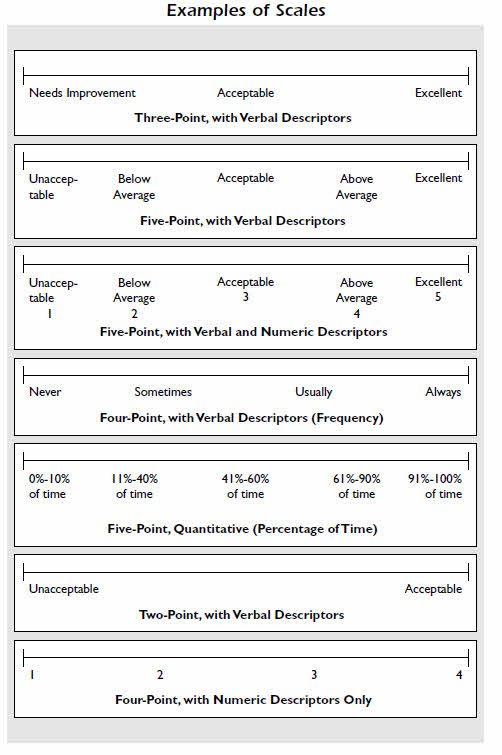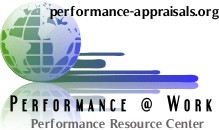Welcome To Employee Rating Scales - Disasters and Wasted Time
If you were to do a survey, you’d find that the most common method of recording or documenting performance is the rating system. You’re probably familiar with ratings both as an employee and a manager. Typically the manager uses (sometimes is forced to use) a form that has a number of statements on it describing some or all of the following:
• job performance
• attitudes
• abilities
• skills
• behavior
• knowledge
For each statement, the manager is expected to rate the employee on a scale. The scales vary somewhat. Some have verbal descriptions for each point on the scale, such as “excellent,” “average,” and “needs improvement.” Some have numeric systems running from one to three or one to five or even one to seven. Some use both numbers and a verbal descriptor for each point on the scale. Take a look at the picture below. These are all scales that are used to document employee performance.

The quality and usefulness of these forms runs from absolutely atrocious to fair. It all depends on the skills of the form designer in writing the performance items so they are specific enough and clear enough to have meaning so a manager can use the scaled items intelligently. Let’s look at examples.

This is an absolutely terrible example of a rating item: the
item is not only useless, but bound to make even the most reasonable
employee defensive and angry. The item is so vague
that it’s unlikely you could get any two people to
agree on its meaning and
it’s likely that two people
rating the same person
would rate him or her
quite differently. The rating
given on such a vague
item is as much a reflection
on the rater/manager
as on the employee.
Here’s the real crunch, though. If the goal is to identify barriers to performance and improve performance, how does this item get us there? Clearly it doesn’t, at least not on its own.
Let's take a look at another example:

What differences can you identify between the two examples?
The first thing that should jump out at you is that this example is far more specific and observable than the first one.
If one wanted, one could actually collect data to support an accurate rating.
If you were to take two people and ask them what
this item means, you’d find they both understand its meaning in
the same way. Finally, it describes behavior, something the
employee actually does. This kind of item is far less likely to
push the employee into defensive behavior during the review
meeting, since it’s not a comment on his or her personality and
is less personal than the first example.
The point here is that a form that has items like the second example can be useful as a starting point for performance improvement. If it turns out the employee hasn’t been responding quickly enough to customer requests, then the next step is clear: manager and employee can then discuss why that’s happening.
That’s a much better, easier, and more comfortable discussion than would occur with our first example. The first example is a starting point for arguments and bad feelings. If you rate an employee as below average on “enthusiasm and motivation,” where in heck do you go after that? How can you address such a vague, nebulous description so improvement happens? You can’t.
Unfortunately, you may not be in a position to determine
which forms you use. You may have no choice, even if the forms
are truly terrible. We’ll help you maximize the usefulness of these
forms in a moment. Before we turn to that topic, let’s quickly
explain how these forms can be used and their limitations.
While there are horrible forms to rate employees, and somewhat better forms, there are NO excellent ones when it comes to improving performance. Forms don't improve anything!
